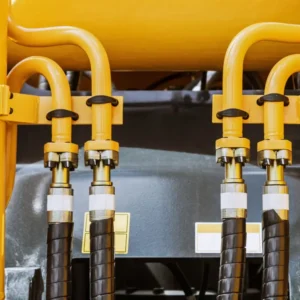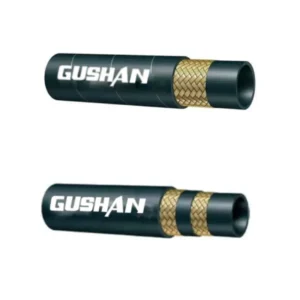Winter weather can bring significant challenges, especially for those tasked with clearing snow. A reliable snow plow is essential, but its performance hinges on the quality of its components. One critical component is the hydraulic hose.
A well-maintained hydraulic hose system ensures smooth and efficient operation of your snow plow. However, over time, these hoses can deteriorate due to exposure to harsh winter conditions, leading to leaks, reduced performance, and costly repairs.
In this blog post, we’ll delve into the importance of hydraulic hoses for snow plows, how to identify signs of wear, and tips for choosing the right replacement hose to maximize your snow removal efficiency.
What Is Snow Plow
A snow plow is a device attached to a vehicle, typically a truck or tractor, designed to remove snow and ice from roads, driveways, and other surfaces. It consists of a large blade or plow that pushes snow to the side, clearing a path for vehicles. Snow plows are essential tools for maintaining safe and accessible roads during winter months, especially in regions with heavy snowfall.
Hydraulic Hoses for Western Plows
Hydraulic hoses are essential components of a Western plow system. They transmit hydraulic fluid from the truck’s hydraulic pump to the plow’s hydraulic cylinders, enabling the plow to lift, angle, and adjust its position.
Key Factors to Consider When Choosing Hydraulic Hoses for Your Western Plow:
- Compatibility: Ensure the hoses are compatible with your specific Western plow model and hydraulic system.
- Durability: The hoses should be made from high-quality materials that can withstand harsh winter conditions, including extreme temperatures, salt, and debris.
- Flexibility: Flexible hoses allow for smooth operation of the plow and prevent damage from twisting and bending.
- Pressure Rating: The hoses must be rated for the high pressures generated by the hydraulic system.
- Fittings: The fittings on the hoses must match the fittings on the plow and truck.
Signs of a Worn or Damaged Hydraulic Hose:
- Visible damage: Cracks, cuts, or abrasions on the hose’s surface.
- Leaks: Fluid leaking from the hose or fittings.
- Reduced performance: Slow or sluggish operation of the plow.
- Unusual noises: Hissing or grinding sounds from the hydraulic system.
Regular Inspection and Maintenance
Regularly inspect your hydraulic hoses for signs of wear and tear. Replace any damaged hoses promptly to prevent costly repairs and downtime. It’s also important to keep the hoses clean and protected from damage.
By using high-quality hydraulic hoses and performing regular maintenance, you can ensure the optimal performance of your Western plow throughout the winter season.
Need to replace your Western plow’s hydraulic hoses? Contact us today for expert advice and high-quality replacement parts.
How to Install Hydraulic Hose for Snow Plow
Disclaimer: While this guide provides a general overview, specific installation procedures may vary depending on your plow model and manufacturer. Always consult your owner’s manual or seek professional assistance if you’re unsure.
Tools and Materials Needed:
- Replacement hydraulic hose kit (includes hose, fittings, and clamps)
- Hydraulic fluid
- Wrench set
- Hose cutter (if necessary)
- Clean rags
- Safety glasses and gloves
Steps about installing hydraulic hose for snow plow:
Jack Up the Truck:
Safely jack up the front of your truck to access the underside of the plow. Use jack stands to secure the vehicle.
Drain Hydraulic Fluid:
Locate the drain plug on the hydraulic reservoir and drain the fluid into a suitable container.
Disconnect Old Hose:
Use a wrench to loosen and remove the fittings from both ends of the old hose. Be careful not to damage the threads.
Prepare the New Hose:
Cut the new hose to the correct length, ensuring you have enough extra length for bending and routing.
Use a hose crimping tool to attach the fittings to the hose ends, following the manufacturer‘s instructions.
Connect the New Hose:
Screw the fittings onto the new hose, ensuring a tight connection.
Route the hose along the frame of the truck, avoiding sharp bends and potential pinch points.
Connect the hose to the fittings on the plow and hydraulic pump.
Bleed the System:
- Fill the hydraulic reservoir with fresh fluid.
- Cycle the plow up and down several times to bleed out any air bubbles in the system.
- Check for leaks at the connections.
Lower the Plow and Check for Leaks:
- Lower the plow to its full down position and inspect all connections for leaks.
- Tighten any loose fittings as needed.
Test the Plow:
Raise and lower the plow, and angle it left and right. Ensure smooth operation and no leaks.
Additional Tips:
- Cleanliness: Keep the work area clean to prevent dirt and debris from entering the hydraulic system.
- Safety First: Always wear safety glasses and gloves when working with hydraulic systems.
- Consult the Manual: Refer to your plow’s specific manual for detailed instructions and torque specifications.
- Professional Installation: If you’re unsure about any step or encounter difficulties, consult a professional mechanic or hydraulic specialist.
By following these steps and taking necessary precautions, you can successfully replace a hydraulic hose on your snow plow and ensure its optimal performance.
Snow Plow Hydraulic Hose Maintainance
Maintaining Your Snow Plow’s Hydraulic Hoses
Proper maintenance of your snow plow’s hydraulic hoses is crucial to ensure optimal performance and longevity.
Here are some essential tips to expand hydraulic hose service life:
Regular Inspections:
- Visual Inspection: Regularly check for signs of wear and tear, such as cracks, cuts, abrasions, or leaks.
- Fluid Level: Ensure the hydraulic fluid level is adequate and that the fluid is clean and free of contaminants.
- Fittings: Inspect the fittings for tightness and signs of corrosion.
- Hose Routing: Verify that the hoses are routed correctly and securely, avoiding sharp bends or excessive stress.
Cleaning and Lubrication:
- Clean the Hoses: Remove dirt, salt, and other debris from the hoses using a cleaning solution and a soft brush.
- Lubricate Fittings: Apply a light coat of hydraulic fluid to the fittings to prevent corrosion and ensure smooth operation.
Replacement:
- Signs of Replacement: If you notice any signs of damage, such as cracks, leaks, or excessive wear, it’s time to replace the hose.
- Professional Installation: It’s recommended to have hydraulic hoses replaced by a qualified technician to ensure proper installation and system performance.
Additional Tips:
- Avoid Extreme Temperatures: Extreme cold can stiffen hoses, while extreme heat can weaken them.
- Protect from Abrasion: Shield hoses from sharp edges or abrasive surfaces.
- Store Properly: During off-season storage, store your plow in a clean, dry environment to protect the hoses from damage.
By following these maintenance tips, you can significantly extend the life of your snow plow’s hydraulic hoses and ensure reliable performance throughout the winter season.
Conclusion
By prioritizing the maintenance and replacement of your hydraulic hoses, you can significantly enhance the performance and longevity of your Fisher plow. Regular inspections, timely repairs, and the use of high-quality hydraulic hoses are essential for efficient snow removal.
Ready to optimize your snow removal operation? Contact us today to receive a customized quote for your specific hydraulic hose needs. Our team of experts is dedicated to providing top-quality products and exceptional service.
Quote Your Hydraulic Hoses Now!



